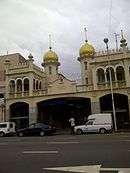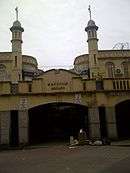Juma Masjid Mosque
| Juma Masjid Mosque | |
|---|---|
-20140223.jpg) | |
| Basic information | |
| Location |
|
| Affiliation | Sunni Islam |
| Province | Kwazulu-Natal |
| Architectural description | |
| Architectural type | Mosque |
| Architectural style | Geometrical |
| Completed | 1930 |
| Specifications | |
| Capacity | 6,000 (increased to 7,000 during the Salat al Eid) |
| Minaret(s) | 8 |
The Juma Masjid Mosque (Juma Masjid, Arabic:جمعة مسجد , meaning Mosque of The Congregation) is a mosque located in Durban, Kwazulu-Natal in the Republic of South Africa.
History

In August 1881, a site was bought by Aboobaker Amod Jhaveri and Hajee Mohamed in Grey Street from K. Munsamy for 115 pounds for the construction of a mosque. A tiny brick and mortar structure which stood on the site was converted into the mosque. Later the adjacent land was bought to expand the mosque. Historic Juma Masjid Mosque in Grey Street, Durban. Photograph courtesy of the Local History Museum. The Juma Masjid was the first mosque to be built in Durban. It has a unique design and is geometric in shape. In 1884 it was expanded to accommodate 200 prayer mats and presently can accommodate about 6000 worshippers. Every Friday Grey Street (now known as Dr. Yusuf Dadoo Street) in Durban is abuzz with over thousands of Muslims going to the mosque to pray. Also known as the Grey Street Mosque, it represents a spiritual center for Durban's Muslims. It was built 1880s and completed 1930s, and together with Madressa Arcade which runs through it, replaced the original series of buildings that had popped up with the arrival of non-indentured Indians in Durban in the late 1800s. The mosque is actually a series of interlinking buildings, arcades and corridors, in which commerce, religion and community exist in equilibrium.
Origin
-20140223-.jpg)
In August 1881 Aboobaker Amod Jhaveri together with Hajee Mahomed Hajee Dada purchased a site in Grey Street (now known as Doctor Yusuf Dadoo Street) from K Moonsamy for one hundred and fifteen pounds with the intention of building a mosque there. A tiny brick and mortar structure which was situated on the site was converted into the mosque. In 1884 the two founders had the brick and mortar structure rebuilt, making it bigger. The Juma Masjid was the first mosque constructed in Natal, and in February 1884 Aboobaker's estate bought land next to the mosque to enable its further expansion.
In 1889 Hajee Mahomed Dada, in his capacity as the only surviving trustee of the Grey Street (now known as Doctor Yusuf Dadoo Street) Mosque purchased more adjoining land due to the swift rise in the number of worshippers. The first of the two minarets on the Grey Street (now known as Doctor Yusuf Dadoo Street) Mosque was constructed in 1904. At the same time, two shops were built alongside the mosque providing an income for its maintenance. A second minaret was added to the mosque in 1905 and several rooms, toilets and shower facilities were also added at the rear of the mosque for travelers to use. Rooms were also built for the mu'adhdhin, who calls worshippers to prayer. All these dwellings had to be removed when the Juma Masjid Girls School was built adjacent to the mosque. These minarets were at time two of the highest structures in the city of Durban.The mosque was rebuilt in 1927 following the design of architects Payne and Payne. The building is a unique blend of Islamic decorations and strong Union period vernacular style. Further extensions and alterations were made to the Grey Street (now known as Doctor Yusuf Dadoo Street) Mosque in 1943.
Today the mosque building is a large plastered structure which features a mixture of various styles. A bridge extends from the neighbouring girls' school to the roof of the mosque. The flat roof, which is used for prayer during festivals is used as a playground during school days as the school is not equipped with one. The style of the Grey Street (now known as Doctor Yusuf Dadoo Street) Mosque is essentially geometrical. The windows and interleading doors and the arched doorways all stress this geometrical design. It's gilt-domed minarets protrude above the bustling commercial area, but inside the marbled worship hall is peaceful and boasts a simple elegance. The Grey Street (now known as Doctor Yusuf Dadoo Street) Mosque until the late 1970s enjoyed the status of being the largest mosque in the southern hemisphere.
Madrassa arcade


See also
- Islamic art
- Nizamiye Masjid
- List of mosques
- List of mosques in Africa
- List of largest mosques
- List of the oldest mosques in the world